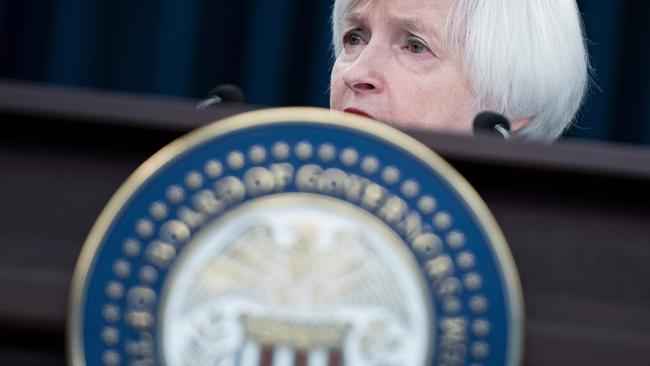US Fed heading for uncharted waters as it plans to shrink balance sheet

The Fed has conditioned markets to expect that it will move cautiously and in a very measured and predictable fashion to begin unwinding the $US3.6 trillion of bond and mortgages it made during the three quantitative easing programs that began in 2008 and which inflated its balance sheet from about $US900 billion to $US4.5 trillion.
It is expected that when it stops reinvesting all the proceeds of maturing securities, perhaps from next month, it will initially reduce its balance sheet by about $US10 billion a month, with the level of non-reinvestment rising subsequently every quarter until it eventually reaches $US50 billion a month.
By laying out a formulaic “set and forget’’ approach to the winding down of its balance sheet the Fed hopes that it won’t unsettle financial markets.
That’s not necessarily going to be the case. The QE programs, combined with ultra-low interest rates, along with similar asset purchases by the other major central banks, were unprecedented.
The massive boost in cheap liquidity — the Fed, European Central Bank and Bank of Japan between them have injected about $US15 trillion into the global financial system since the crisis — undoubtedly has played the major role in the search for yield and returns that has driven bond yields down and stock and property markets up.
If central banks’ balance sheet expansions were unprecedented and significantly inflated financial asset values during a period when the major economies, while now growing, have been growing at quite modest rates, then withdrawing that liquidity — no matter how cautiously — might be expected to also have an impact on financial asset values.
Despite the lengthy advance warning the Fed has given markets, or perhaps because of it, they appear completely unperturbed by the prospect of an imminent announcement of the start of the wind-down of the Fed’s balance sheet.
That’s in contrast to what happened in 2013, when the first suggestion that the Fed might reduce the scale of its asset purchases produced the violent “taper tantrum’’, with bond yields spiking and equity markets slumping.
Ahead of the Fed’s meeting the US stockmarket hit record levels again overnight while the bond market remained quite calm.
There appears to be a view that, with the ECB and Bank of Japan still buying securities, the moment when changes in central bank balance sheet strategies have material consequences for markets is still some years away. The ECB is expected to reduce the scale of its asset purchases again next year but the prospect of an actual reduction in the size of its balance sheet is still a long way off.
The Fed also has the ability to offset to some degree the impact of the withdrawal of liquidity from the economy with a more conventional monetary policy tool.
While there remains some chance (the market assigns it about 50 per cent) that the Fed will raise its policy rate in December, for the fourth time in the post-crisis era, the Fed can finesse the timing of the normalisation of its policy rates to take into account the impacts of the balance sheet shrinkage.
With a current range of one per cent to 1.25 per cent even as the US economy is growing and the US unemployment rate is only 4.4 per cent, the federal funds rate today remains at abnormally low levels. The balance sheet strategy is likely to slow further the rate at which the Fed normalises US rates.
One uncertainty about the future pace and direction of the balance sheet strategy is what might happen if the US economy were to turn down, or another financial crisis were to develop. Presumably, while it doesn’t have a lot of scope to cut interest rates, the Fed would reignite a quantitative easing program.
The other wildcard for the direction and pace of US monetary policy normalisation is the composition of its board.
As discussed recently there will be four vacancies on the seven-member Fed board once its vice-chairman, Stanley Fischer, retires next month. The term of the Fed’s chair, Janet Yellen, expires in February although she could, if she wished, remain a governor until 2024.
The vacancies give the Trump administration the opportunity and need to appoint a majority of the Fed’s board. That could lead to a significant shift in strategy from what has been an ultraconservative approach from the Yellen-led board.
Some of the names of potential directors and, indeed, potential chairmen, are people whose public commentaries would suggest they would be far more “hawkish’’ and aggressive in normalising monetary policy than the current governors.
The post-crisis strategies of the key central banks have resulted in a massive increase in global debt levels as well as inflated asset values that some might describe as “bubbles.’’
A decade after the crisis emerged and nearly nine years after the Fed announced the launch of its first quantitative easing program — and after more than eight years of a bull market for stocks — the Fed will now, it seems, move into uncharted but potentially quite dangerous (for investors and the overly-indebted) waters.
If it misjudges the rate at which it starts to withdraw liquidity from the financial system, it could trigger an over-reaction in markets that have been remarkably sanguine about the approach of a watershed moment in the post-crisis era, with spill-over effects for the real economy.
The significance of the US financial system and the role that the US dollar plays within the global economy and financial system means that any adverse or disruptive consequences from changes to US monetary policies will inevitably have global implications and consequences. There’s a lot riding on the Fed managing the process, and markets’ expectations, well.




In the US later today the Federal Reserve Board starts what will be one of the milestone meetings in its post-crisis history, with a general expectation that when the meeting ends tomorrow it will announce the beginning of the protracted process of shrinking a balance sheet bloated by its response to the crisis.